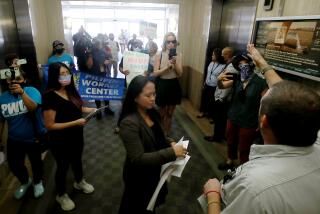Working on Reform
- Share via
Backed by a new study showing the dramatic economic losses endured by employees who suffer disabling injuries on the job, a political push has begun for another overhaul of California’s workers’ compensation system.
For starters, the reform ideas--all of which face an uphill battle in Sacramento--include simply boosting benefits for workers with permanent disabilities. Another idea is to make benefits fairer by linking payments more closely to the actual wage losses experienced by workers with various kinds of disabilities.
The state-funded study sparking the reform push, conducted by Santa Monica-based Rand Corp., also calls for finding ways to help injured employees return to work faster and to hold on to their jobs despite their disabilities.
Perhaps the most innovative proposal in the Rand report involves developing a “fast-track” option for speeding the processing of disability claims and for more quickly resolving disputed cases. The goal is to cut litigation costs and unnecessary delays for both employers and employees.
These proposals will be aired at a conference Friday in San Francisco sponsored by an independent state agency, the California Commission on Health and Safety and Workers’ Compensation.
Rand’s research provides a compelling argument for reform of the state’s $8-billion workers’ compensation system, which previously went through major overhauls in 1989 and 1993. The think tank’s researchers found that in the first five years after reporting permanently disabling injuries, workers lose an average of 40% in wages, yet get less than half of that back in benefits.
What’s more, although the study looked only into the first five years after a worker claims a disability, researchers said employees appear to continue suffering economically indefinitely.
In terms of the ability of disabled workers to earn a living, “these people have not recovered after five years, yet the vast majority no longer are receiving benefits” from workers’ compensation, said Robert T. Reville, one of three authors of the Rand report.
The percentage of lost wages replaced by workers’ compensation insurance was lowest for employees with the least serious permanent disabilities. That category includes workers with such problems as carpal tunnel syndrome, back injuries, blindness in one eye or loss of a finger.
For instance, the study found that a worker suffering an amputated finger on the job would receive just over $6,600 in financial compensation, but would suffer wage losses over five years of $31,300. The study, which tracked what happened to workers who filed disability claims in 1991 through 1993, found that much of the average 40% wage loss occurs because disabled workers are more likely to be out of the labor force.
But when disabled workers returned to the job, they continued to earn about 20% less than did their able-bodied counterparts.
Complicating any effort to overhaul the way permanent disability benefits are paid is the vast array of interest groups involved in the state’s workers’ compensation system, including large and small employers, insurance companies, unions, doctors, lawyers and vocational rehabilitation specialists. And that still doesn’t include the 100,000 to 200,000 California workers classified every year as permanently disabled by on-the-job injuries.
All of the interest groups are expected to be represented at Friday’s conference.
While some business groups are sympathetic to increasing benefits for seriously disabled workers, they also want to limit their own costs and curb abuses by workers who allegedly make false or inflated injury claims.
*
Times staff writer Stuart Silverstein can be reached by phone at (213) 237-7887 or by e-mail at stuart.silverstein@latimes.com
More to Read
Get the L.A. Times Politics newsletter
Deeply reported insights into legislation, politics and policy from Sacramento, Washington and beyond. In your inbox twice per week.
You may occasionally receive promotional content from the Los Angeles Times.










